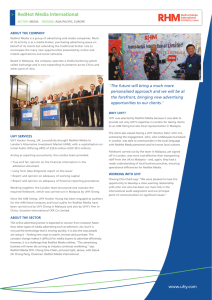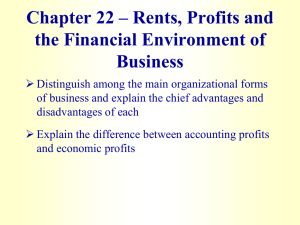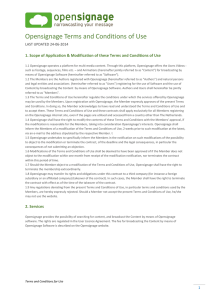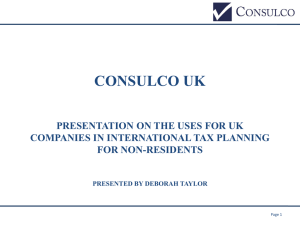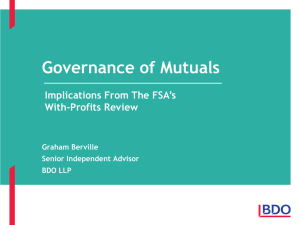Ladislav Hornan
advertisement
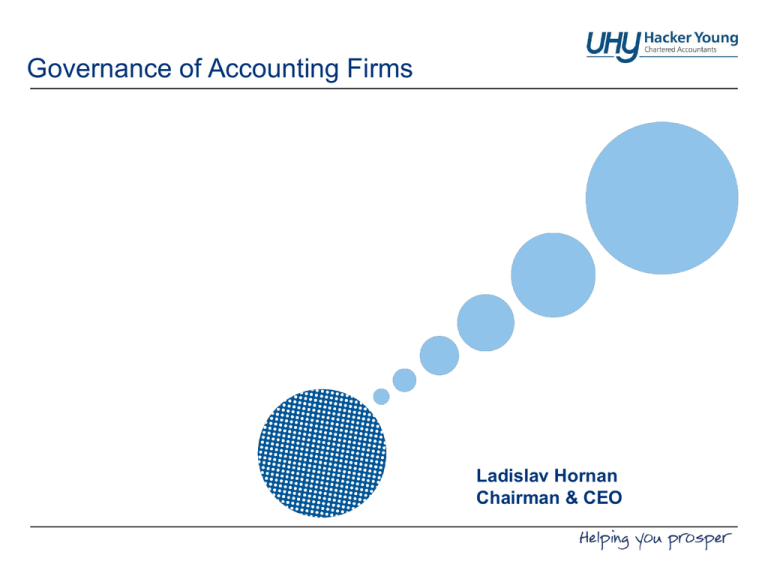
Governance of Accounting Firms Ladislav Hornan Chairman & CEO Page 1 What we will cover today – – – Structure of a Limited Liability Partnership (30 minutes) Partner Profit Sharing Arrangements (20 minutes) Accounting and Financial Management (10 minutes) Page 2 Structure of a Limited Liability Partnership – – – – – History of LLPs in the UK Why convert to a Limited Liability Partnership? UHY Hacker Young case study What are the key issues to consider? LLP agreements – what they should contain and why Page 3 History of LLPs in the UK – – – – – – – Until recently professional service firms in the UK were only allowed to form unlimited liability partnerships In 2001 the government in the UK agreed to the introduction of Limited Liability Partnerships This was an important step in protecting partners against the wrongdoings / failures of one or a group of them The rules do not protect the partner that erred from liability, and although liability insurance can reduce the financial impact the business as a whole can still fail The culture of the firm determines whether it is run in a similar way to a partnership or as more of a corporate structure e.g. how much power is given to the Managing Partner LLP agreements allow flexibility of management Most firms have an elected policy-making group and an appointed executive group Page 4 Why convert to a Limited Liability Partnership? – – – – – – A Special General Partnership 特殊普通合伙 in China is similar to a Limited Liability Partnership in the UK This type of partnership is only available to professional service institutions offering services requiring professional knowledge and special skills The structure shields partners from liabilities due to the wilful misconduct or gross negligence of one partner or a group of partners As protection for clients and third parties these firms must maintain a risk reserve fund and obtain liability insurance to cover potential risks incurred by partners The Ministry of Finance in China is encouraging all medium sized firms to convert to this status Although it appears that conversion to this structure would mean a move from 1 or 2 leaders to a greater ownership spread, the day-to-day management of the firm in fact need not significantly change Page 5 UHY Hacker Young LLP case study: Structure Partnership Networks Chaired by Managing Partner UHY HY Group Executive Committee Chaired by Managing Partner UHY International LLP membership agreement Guidance, policy and ultimate decision making body Elected by secret ballot every 3 years Strategy, operating policy, monitoring and controls Managing Partner Nottingham Operations Taxation Services Audit & Bus. Advisory International Bus. Desk Audit Corp Tax Audit /Bus adv. China Tax Personal tax Gen. Practice Client Serv & Fin Plan Payroll Services Int. Tax Corp. Finance Page 6 Specialist Services Corp. Rec. Support Functions Tech & train. CIS/ CEE Corp. Finance Marketing & BD Trusts India Lit. Support Finance VAT Malaysia Company Sec. IT & Admin Int. Tax US Israel Info Services UHY Hacker Young case study: Chairman and Managing Partner – Ladislav Hornan: Chairman and Managing Partner since 1995 – Managing the day-to-day decision making process and oversight of the firm – Policy determination and implementation – Responsibility for management and quality control – Overseeing coordination and direction of marketing and business development within the firm – Financial control – Representation on national and international Boards Page 7 UHY Hacker Young case study: How does the business model work? – Day to day business decisions are principally carried out by the managing partner. In the event of departure from normal policy, a consultation will be held with the Executive Committee. – This entails a more corporate style of management but only on daily business issues. Policy is determined by the Executive Committee and, in some cases, by all equity partners. The Executive Committee meets each month to review a range of issues. – The managing partner meets monthly with the heads of the larger client service departments and four or more times a year with the heads of other departments and support teams. – Equity partners meet at least twice a year, mainly to deal with a range of issues such as admitting new partners, profit sharing arrangements and mergers and acquisitions. – All partners meet at least twice a year to agree budgets and review the financial position and business performance. Page 8 What are the key issues to consider? – To manage a firm in this way you need to remember that: – Your authority to manage is derived from your partners’ willingness to be managed – Partners perceive themselves to be owners, not employees – Every firm has its own personalities, cultures and management techniques that may not be effective elsewhere Page 9 LLP agreements – what they should contain and why There is flexibility in what you can include but some aspects are very important – – – – – – – – – The proportion in which partners own the business and their contribution to capital Who is entitled to profits – and who is liable for losses Rules for taking money out (drawings) What happens in the case of sickness / death What happens if someone wants to leave or retire from the firm and repayment of their capital Management of the firm Decision making including voting rights Restrictions on competition Ownership of assets (please refer to ‘LLP Agreement Clauses’ handout) Page 10 Example 1: Voting rights – – – – To require unanimous agreement in relation to certain decisions may be too restrictive where there are a number of partners Agreements can therefore dictate special majorities for certain decisions Where partners feel strongly about a certain issue a higher percentage vote can be required Need to be wary of partners’ ability to ‘block’ changes (Please refer to handout ‘Voting Rights’) Page 11 Example 2: Drawings by partners - Drawings are cash advances paid throughout the year against anticipated profits The agreement should detail - Page 12 Rules for drawings (how and when they can be made) and their accounting treatment How much of the anticipated profits can be drawn and when What happens if anticipated profits are over / under estimated – which highlights the importance of good cash flow management Example 3: Leaving the firm – – – – – A partner may leave the firm due to death; by agreement with other partners; by giving notice to other partners; upon retirement; or due to expulsion The agreement should always provide what payments a partner is entitled to in each of these circumstances The level of partner capital in the firm will form part of the firm’s annual accounts Partners will usually leave the firm at the financial year end but if not it may be necessary to require a set of accounts be prepared at the leaving date as a basis for calculating capital and profit share on departure The agreement could provide for any payment to be made in instalments to ease the financial burden on the firm Page 13 Partner Profit Sharing Arrangements – A case study of how profits are shared in London – Types of partner and exceptions – Why a points-based system works – Examples of individual partner remuneration Page 14 Types of partner – In UHY Hacker Young there are 3 levels of partner, designed to motivate partners to progress within the firm. The senior level (‘equity’) also acts as the ultimate decision-making body. The levels are: – Associate: normally a two year salaried appointment with a partner development programme. – Fixed share: this next step normally lasts three years with a limited share in the firm’s actual performance. – Equity: at this level the partner achieves a gradual increase in the share of profits which is only adjusted every 3 years and has full partner (equal) rights in decision making. – The Managing Partner can also issue discretionary bonuses – this is important to reward exceptional performance and to deal with any anomalies – This system is stable, transparent and to some extent predictable Page 15 Exceptions – It is possible to make exceptions to this structure and to remunerate a partner on a special basis – This is common in the UK where the nature of the work and fees generated by an individual are non-recurring such as in corporate finance and insolvency – Also a good idea where a firm is trying to grow a new activity or service line – Good way to attract and retain talented individuals – Remuneration could be based on profits e.g. 25-35% of net profits – Remuneration could be based on fees e.g. 10-15% of fees received – There must be clear rules around such structures to avoid tensions Page 16 Why a points-based system and other incentives work well – – – – – – – Maximising profits is important to partners as there is no goodwill value to a partners’ client base – ‘naked in, naked out’ The points system encourages partners to contribute to the profitability of the whole firm, not just their area Partners more likely to work together and not in ‘silos’ Clear progression structure Potential to review profit share and a mechanism to review points up (or down) every 3 years if there is proof of a sustainable increase in performance (not annually to avoid increments due to large non-recurring work) Transparency of performance due to financial reporting by firm / department / individual Managing partner has the power to motivate individuals with a discretionary profit share (to be agreed / vetoed by the Executive Committee) Page 17 Evidence to support the points system 2008 2009 2010 2011 Proportion of total profit in ‘T1’ 51.6% 71.4% 56.7% 49.4% Proportion of total profit in ‘T2’ 45.7% 26.5% 41.4% 48.2% Proportion of total profit in ‘T3’ 2.7% 2.1% 1.9% 2.4% Var Actual value of single point £ Page 18 9,541 3,893 -60% Var Var 7,812 +100% 10,570 +35% Accounting and Financial Management – Accounting and financial reporting are important tools in the management of an LLP. Firms can benefit from producing regular: – – – – – Reporting Budgets Management accounts Performance measures and benchmarking (KPIs) In the UK there there is a culture of time recording of work done for clients whilst at the same time recognising the need to deliver value to clients by setting fees at fixed or predictable levels Page 19 Reporting – Fees and cash – weekly – Working capital lock up – monthly with targets for billing and collections – Management accounts – Quarterly financial results Page 20 Recovery rates by department Example Recovery Rates Audit Business Advisory China Desk PCS (Personal Tax) VAT Corporate Tax PCS (Trust) Corporate Recovery Nottingham Jackson Bly Corporate Finance City Registrars Payroll Services Total Practice - O'all Actual 2009/10 73 76 78 92 87 91 77 78 71 53 124 76 77 Actual 2010/11 75 77 98 79 92 83 94 83 79 80 79 121 72 79 Budget 2011/12 75 75 90 80 92 85 91 83 80 1% change = £x change in profit Page 21 70 124 75 79 Utilisation rates by department Example Utilisation rates Actual 2009/10 Actual 2010/11 Budget 2011/12 Audit 54 54 61 Business Advisory 64 67 66 53 68 China Desk Page 22 PCS (Personal Tax) 58 57 68 VAT 42 38 48 Corporate Tax 65 63 69 PCS (Trust) 69 62 75 Corporate Recovery 65 61 68 Nottingham 57 59 61 Jackson Bly 67 0 0 Corporate Finance 43 33 48 City Registrars 57 65 58 Payroll 49 44 60 Technical & Training 14 10 10 Total Practice - o'all 59 59 63 Utilisation by level of staff Example Actual 2009/10 Actual 2010/11 Budget 2011/12 % % % % Partners 40 42 46 50 Managers 62 64 63 70 Staff 68 65 71 75 Students 54 59 62 60 Total 59 59 63 65 Utilisation 1% change = £x change in profits Page 23 Benchmark KPIs and Performance Measures – Key performance Indicators – Key to performance measurement and target-setting – Enables delivery of a service to be targeted, managed and evaluated, and potential problems identified – Non-financial measures as important as financial measures – Performance measures – Set and reported on by individuals and departments: – Fees – Recovery rates – Staff utilisation (chargeable hours and value of time worked) – Working capital lock up Page 24 Questions? Ladislav Hornan Chairman & CEO UHY Hacker Young e: l.hornan@uhy-uk.com t: +44 (0)20 7216 4600 Page 25
